Molecules and the Mind (Marijuana): A Comprehensive Report
VerifiedAdded on 2023/05/27
|7
|1708
|479
Report
AI Summary
This report provides a detailed analysis of marijuana, focusing on its chemical properties, pharmacology, and societal implications, particularly in the context of legalization. The report begins with an introduction that highlights the global trend of marijuana legalization and its potential medical benefits. It then delves into the science of marijuana, discussing its various components, with a primary focus on tetrahydrocannabinol (THC), its chemical structure, and its mechanism of action within the human body. The absorption, metabolism, and elimination of THC are also discussed. Furthermore, the report examines the societal impact of marijuana, including its effects on mental health, cognitive function, and the potential for addiction, especially among adolescents and young adults. The legal aspects of marijuana consumption, including laws and regulations in Canada, are also considered. The report concludes by summarizing the key risks associated with marijuana legalization and emphasizes the need for controlled usage and enhanced legal considerations.
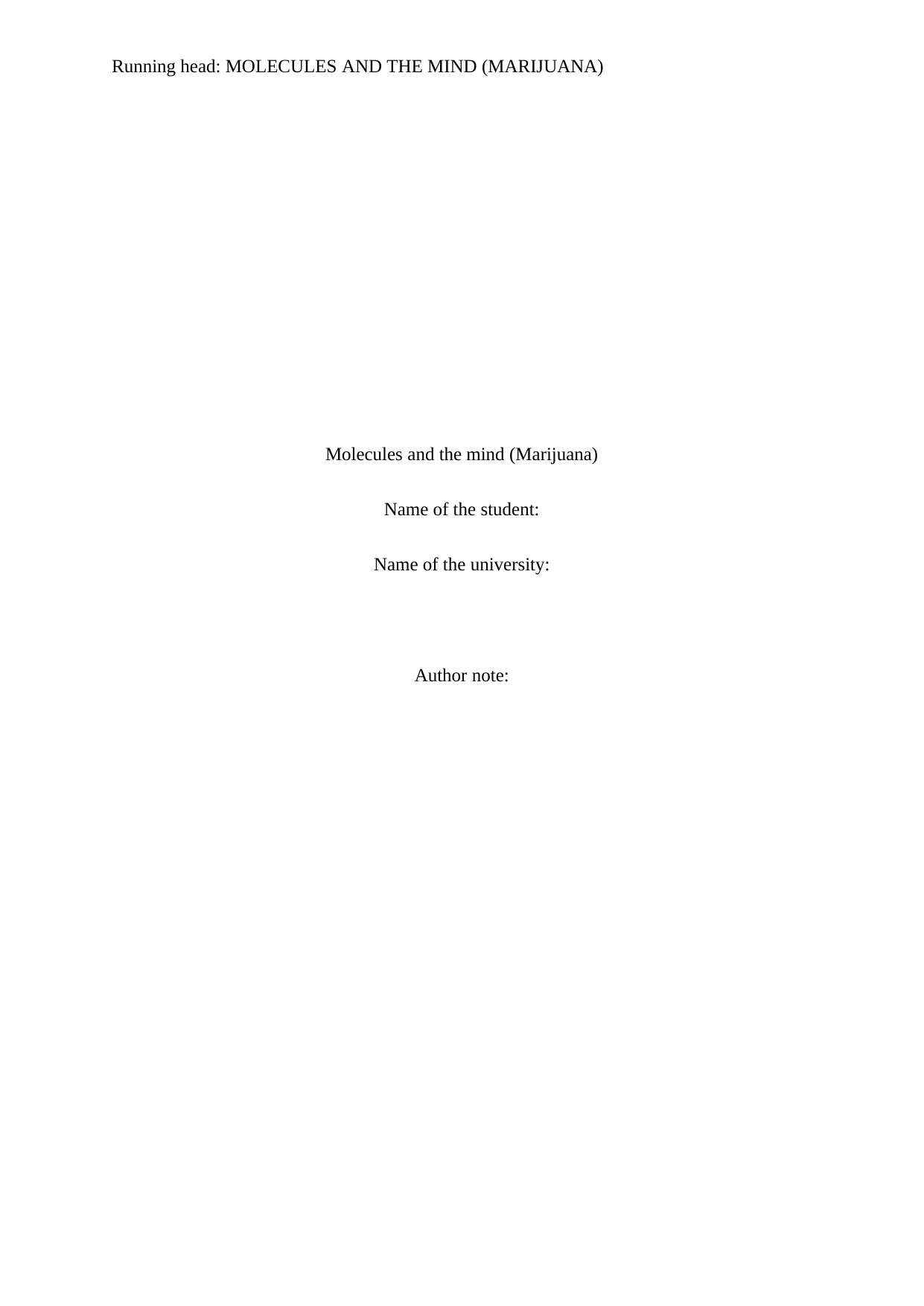
Running head: MOLECULES AND THE MIND (MARIJUANA)
Molecules and the mind (Marijuana)
Name of the student:
Name of the university:
Author note:
Molecules and the mind (Marijuana)
Name of the student:
Name of the university:
Author note:
Paraphrase This Document
Need a fresh take? Get an instant paraphrase of this document with our AI Paraphraser
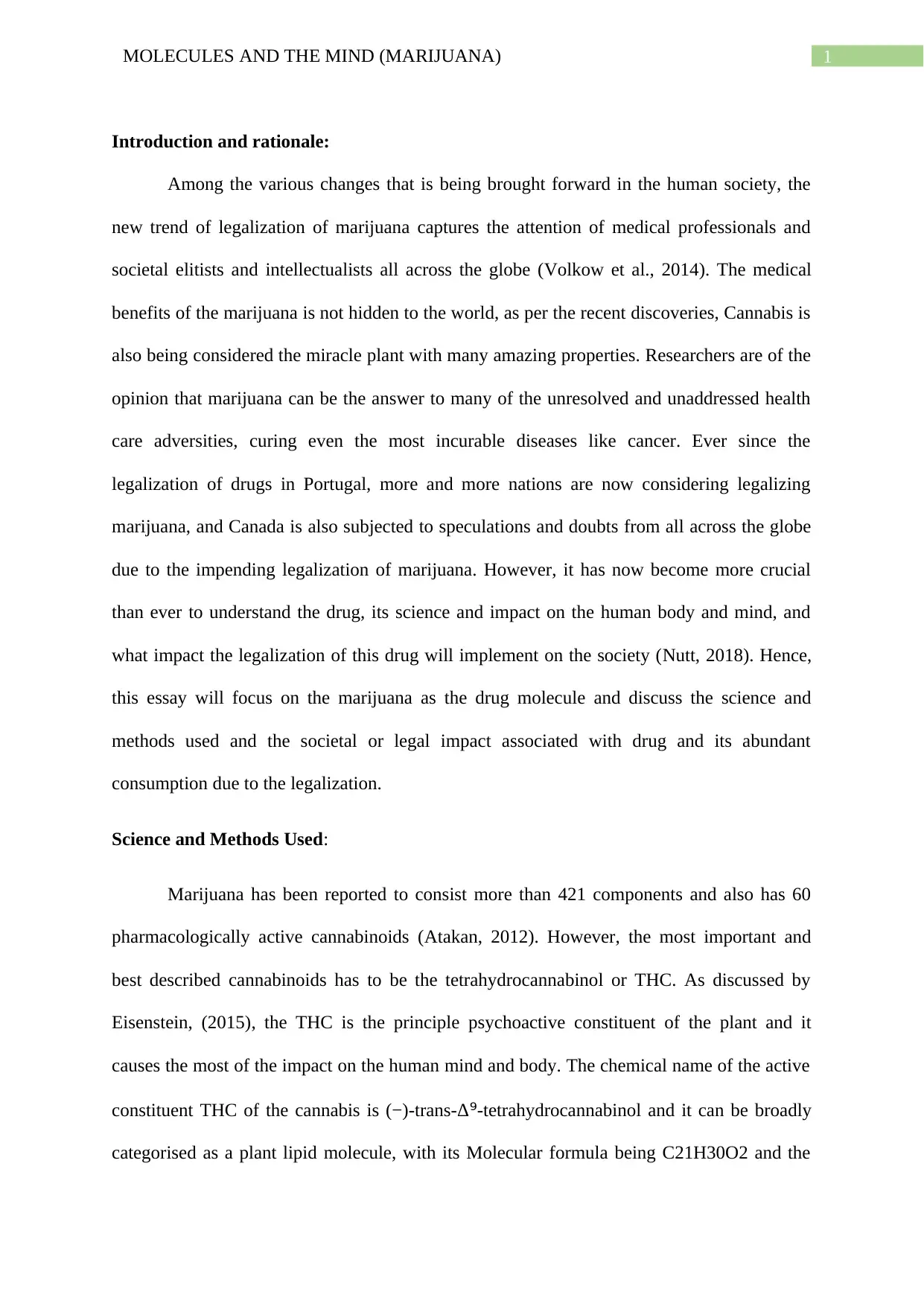
1MOLECULES AND THE MIND (MARIJUANA)
Introduction and rationale:
Among the various changes that is being brought forward in the human society, the
new trend of legalization of marijuana captures the attention of medical professionals and
societal elitists and intellectualists all across the globe (Volkow et al., 2014). The medical
benefits of the marijuana is not hidden to the world, as per the recent discoveries, Cannabis is
also being considered the miracle plant with many amazing properties. Researchers are of the
opinion that marijuana can be the answer to many of the unresolved and unaddressed health
care adversities, curing even the most incurable diseases like cancer. Ever since the
legalization of drugs in Portugal, more and more nations are now considering legalizing
marijuana, and Canada is also subjected to speculations and doubts from all across the globe
due to the impending legalization of marijuana. However, it has now become more crucial
than ever to understand the drug, its science and impact on the human body and mind, and
what impact the legalization of this drug will implement on the society (Nutt, 2018). Hence,
this essay will focus on the marijuana as the drug molecule and discuss the science and
methods used and the societal or legal impact associated with drug and its abundant
consumption due to the legalization.
Science and Methods Used:
Marijuana has been reported to consist more than 421 components and also has 60
pharmacologically active cannabinoids (Atakan, 2012). However, the most important and
best described cannabinoids has to be the tetrahydrocannabinol or THC. As discussed by
Eisenstein, (2015), the THC is the principle psychoactive constituent of the plant and it
causes the most of the impact on the human mind and body. The chemical name of the active
constituent THC of the cannabis is (−)-trans-Δ⁹-tetrahydrocannabinol and it can be broadly
categorised as a plant lipid molecule, with its Molecular formula being C21H30O2 and the
Introduction and rationale:
Among the various changes that is being brought forward in the human society, the
new trend of legalization of marijuana captures the attention of medical professionals and
societal elitists and intellectualists all across the globe (Volkow et al., 2014). The medical
benefits of the marijuana is not hidden to the world, as per the recent discoveries, Cannabis is
also being considered the miracle plant with many amazing properties. Researchers are of the
opinion that marijuana can be the answer to many of the unresolved and unaddressed health
care adversities, curing even the most incurable diseases like cancer. Ever since the
legalization of drugs in Portugal, more and more nations are now considering legalizing
marijuana, and Canada is also subjected to speculations and doubts from all across the globe
due to the impending legalization of marijuana. However, it has now become more crucial
than ever to understand the drug, its science and impact on the human body and mind, and
what impact the legalization of this drug will implement on the society (Nutt, 2018). Hence,
this essay will focus on the marijuana as the drug molecule and discuss the science and
methods used and the societal or legal impact associated with drug and its abundant
consumption due to the legalization.
Science and Methods Used:
Marijuana has been reported to consist more than 421 components and also has 60
pharmacologically active cannabinoids (Atakan, 2012). However, the most important and
best described cannabinoids has to be the tetrahydrocannabinol or THC. As discussed by
Eisenstein, (2015), the THC is the principle psychoactive constituent of the plant and it
causes the most of the impact on the human mind and body. The chemical name of the active
constituent THC of the cannabis is (−)-trans-Δ⁹-tetrahydrocannabinol and it can be broadly
categorised as a plant lipid molecule, with its Molecular formula being C21H30O2 and the
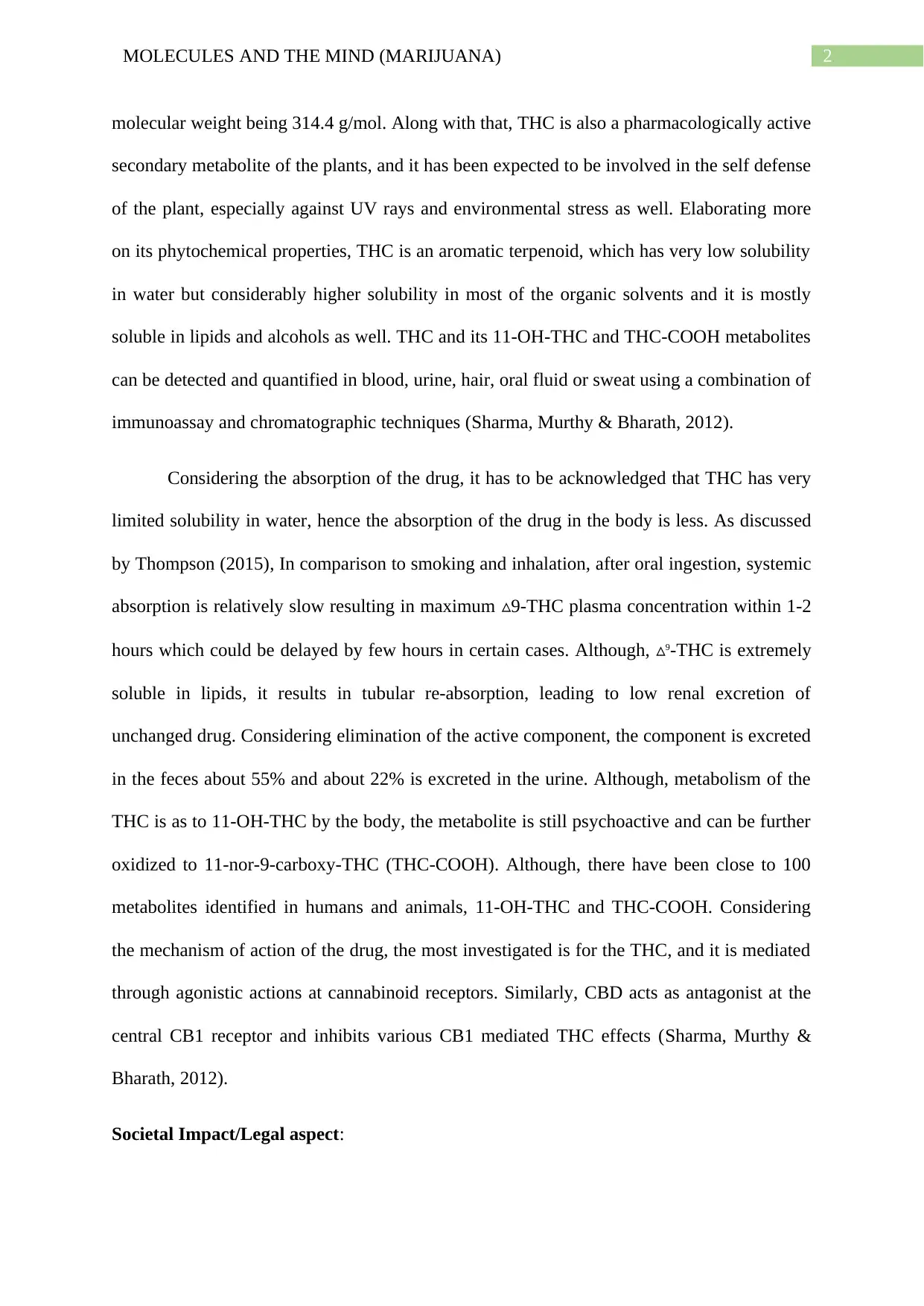
2MOLECULES AND THE MIND (MARIJUANA)
molecular weight being 314.4 g/mol. Along with that, THC is also a pharmacologically active
secondary metabolite of the plants, and it has been expected to be involved in the self defense
of the plant, especially against UV rays and environmental stress as well. Elaborating more
on its phytochemical properties, THC is an aromatic terpenoid, which has very low solubility
in water but considerably higher solubility in most of the organic solvents and it is mostly
soluble in lipids and alcohols as well. THC and its 11-OH-THC and THC-COOH metabolites
can be detected and quantified in blood, urine, hair, oral fluid or sweat using a combination of
immunoassay and chromatographic techniques (Sharma, Murthy & Bharath, 2012).
Considering the absorption of the drug, it has to be acknowledged that THC has very
limited solubility in water, hence the absorption of the drug in the body is less. As discussed
by Thompson (2015), In comparison to smoking and inhalation, after oral ingestion, systemic
absorption is relatively slow resulting in maximum ▵9-THC plasma concentration within 1-2
hours which could be delayed by few hours in certain cases. Although, ▵9-THC is extremely
soluble in lipids, it results in tubular re-absorption, leading to low renal excretion of
unchanged drug. Considering elimination of the active component, the component is excreted
in the feces about 55% and about 22% is excreted in the urine. Although, metabolism of the
THC is as to 11-OH-THC by the body, the metabolite is still psychoactive and can be further
oxidized to 11-nor-9-carboxy-THC (THC-COOH). Although, there have been close to 100
metabolites identified in humans and animals, 11-OH-THC and THC-COOH. Considering
the mechanism of action of the drug, the most investigated is for the THC, and it is mediated
through agonistic actions at cannabinoid receptors. Similarly, CBD acts as antagonist at the
central CB1 receptor and inhibits various CB1 mediated THC effects (Sharma, Murthy &
Bharath, 2012).
Societal Impact/Legal aspect:
molecular weight being 314.4 g/mol. Along with that, THC is also a pharmacologically active
secondary metabolite of the plants, and it has been expected to be involved in the self defense
of the plant, especially against UV rays and environmental stress as well. Elaborating more
on its phytochemical properties, THC is an aromatic terpenoid, which has very low solubility
in water but considerably higher solubility in most of the organic solvents and it is mostly
soluble in lipids and alcohols as well. THC and its 11-OH-THC and THC-COOH metabolites
can be detected and quantified in blood, urine, hair, oral fluid or sweat using a combination of
immunoassay and chromatographic techniques (Sharma, Murthy & Bharath, 2012).
Considering the absorption of the drug, it has to be acknowledged that THC has very
limited solubility in water, hence the absorption of the drug in the body is less. As discussed
by Thompson (2015), In comparison to smoking and inhalation, after oral ingestion, systemic
absorption is relatively slow resulting in maximum ▵9-THC plasma concentration within 1-2
hours which could be delayed by few hours in certain cases. Although, ▵9-THC is extremely
soluble in lipids, it results in tubular re-absorption, leading to low renal excretion of
unchanged drug. Considering elimination of the active component, the component is excreted
in the feces about 55% and about 22% is excreted in the urine. Although, metabolism of the
THC is as to 11-OH-THC by the body, the metabolite is still psychoactive and can be further
oxidized to 11-nor-9-carboxy-THC (THC-COOH). Although, there have been close to 100
metabolites identified in humans and animals, 11-OH-THC and THC-COOH. Considering
the mechanism of action of the drug, the most investigated is for the THC, and it is mediated
through agonistic actions at cannabinoid receptors. Similarly, CBD acts as antagonist at the
central CB1 receptor and inhibits various CB1 mediated THC effects (Sharma, Murthy &
Bharath, 2012).
Societal Impact/Legal aspect:
⊘ This is a preview!⊘
Do you want full access?
Subscribe today to unlock all pages.

Trusted by 1+ million students worldwide
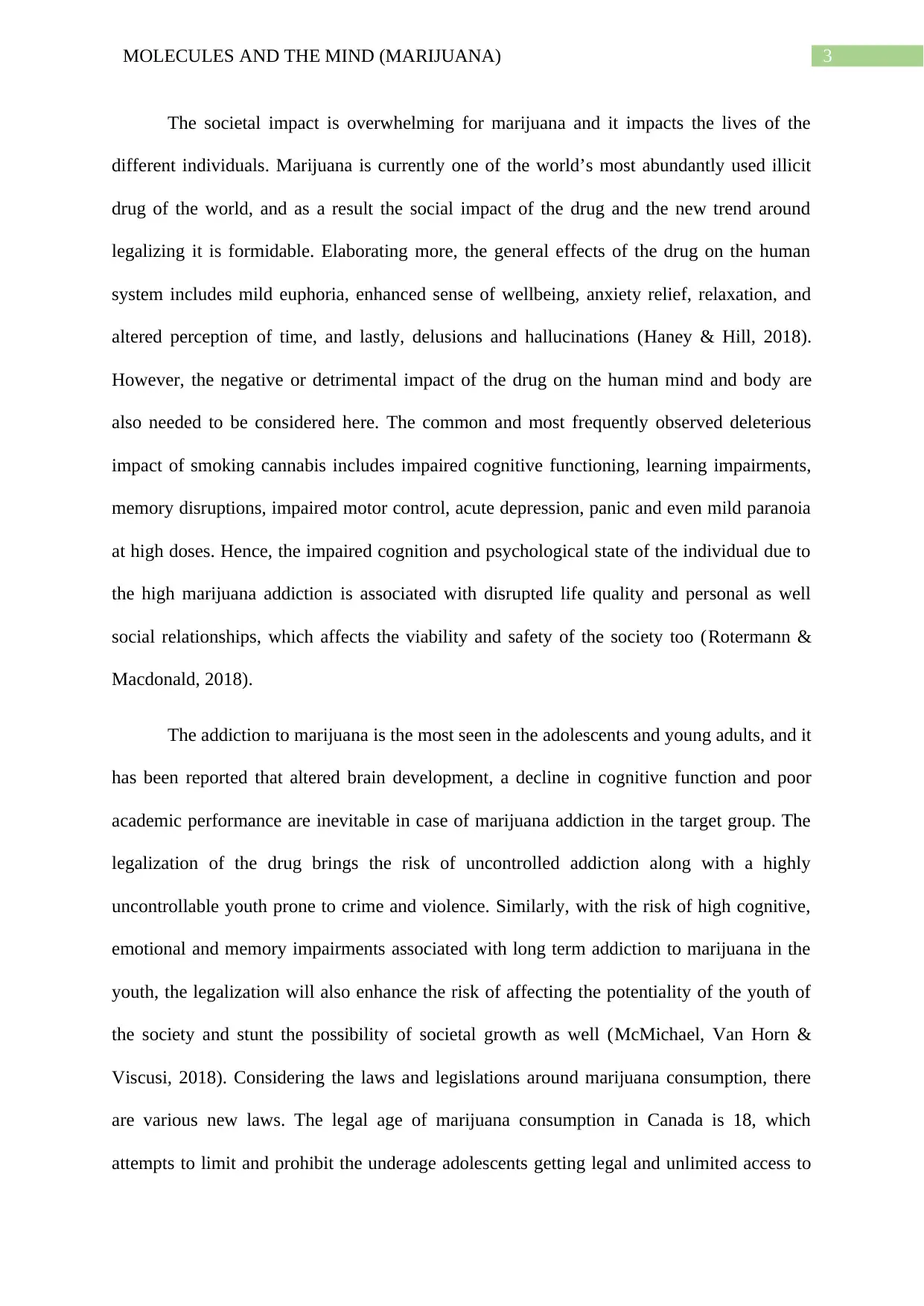
3MOLECULES AND THE MIND (MARIJUANA)
The societal impact is overwhelming for marijuana and it impacts the lives of the
different individuals. Marijuana is currently one of the world’s most abundantly used illicit
drug of the world, and as a result the social impact of the drug and the new trend around
legalizing it is formidable. Elaborating more, the general effects of the drug on the human
system includes mild euphoria, enhanced sense of wellbeing, anxiety relief, relaxation, and
altered perception of time, and lastly, delusions and hallucinations (Haney & Hill, 2018).
However, the negative or detrimental impact of the drug on the human mind and body are
also needed to be considered here. The common and most frequently observed deleterious
impact of smoking cannabis includes impaired cognitive functioning, learning impairments,
memory disruptions, impaired motor control, acute depression, panic and even mild paranoia
at high doses. Hence, the impaired cognition and psychological state of the individual due to
the high marijuana addiction is associated with disrupted life quality and personal as well
social relationships, which affects the viability and safety of the society too (Rotermann &
Macdonald, 2018).
The addiction to marijuana is the most seen in the adolescents and young adults, and it
has been reported that altered brain development, a decline in cognitive function and poor
academic performance are inevitable in case of marijuana addiction in the target group. The
legalization of the drug brings the risk of uncontrolled addiction along with a highly
uncontrollable youth prone to crime and violence. Similarly, with the risk of high cognitive,
emotional and memory impairments associated with long term addiction to marijuana in the
youth, the legalization will also enhance the risk of affecting the potentiality of the youth of
the society and stunt the possibility of societal growth as well (McMichael, Van Horn &
Viscusi, 2018). Considering the laws and legislations around marijuana consumption, there
are various new laws. The legal age of marijuana consumption in Canada is 18, which
attempts to limit and prohibit the underage adolescents getting legal and unlimited access to
The societal impact is overwhelming for marijuana and it impacts the lives of the
different individuals. Marijuana is currently one of the world’s most abundantly used illicit
drug of the world, and as a result the social impact of the drug and the new trend around
legalizing it is formidable. Elaborating more, the general effects of the drug on the human
system includes mild euphoria, enhanced sense of wellbeing, anxiety relief, relaxation, and
altered perception of time, and lastly, delusions and hallucinations (Haney & Hill, 2018).
However, the negative or detrimental impact of the drug on the human mind and body are
also needed to be considered here. The common and most frequently observed deleterious
impact of smoking cannabis includes impaired cognitive functioning, learning impairments,
memory disruptions, impaired motor control, acute depression, panic and even mild paranoia
at high doses. Hence, the impaired cognition and psychological state of the individual due to
the high marijuana addiction is associated with disrupted life quality and personal as well
social relationships, which affects the viability and safety of the society too (Rotermann &
Macdonald, 2018).
The addiction to marijuana is the most seen in the adolescents and young adults, and it
has been reported that altered brain development, a decline in cognitive function and poor
academic performance are inevitable in case of marijuana addiction in the target group. The
legalization of the drug brings the risk of uncontrolled addiction along with a highly
uncontrollable youth prone to crime and violence. Similarly, with the risk of high cognitive,
emotional and memory impairments associated with long term addiction to marijuana in the
youth, the legalization will also enhance the risk of affecting the potentiality of the youth of
the society and stunt the possibility of societal growth as well (McMichael, Van Horn &
Viscusi, 2018). Considering the laws and legislations around marijuana consumption, there
are various new laws. The legal age of marijuana consumption in Canada is 18, which
attempts to limit and prohibit the underage adolescents getting legal and unlimited access to
Paraphrase This Document
Need a fresh take? Get an instant paraphrase of this document with our AI Paraphraser
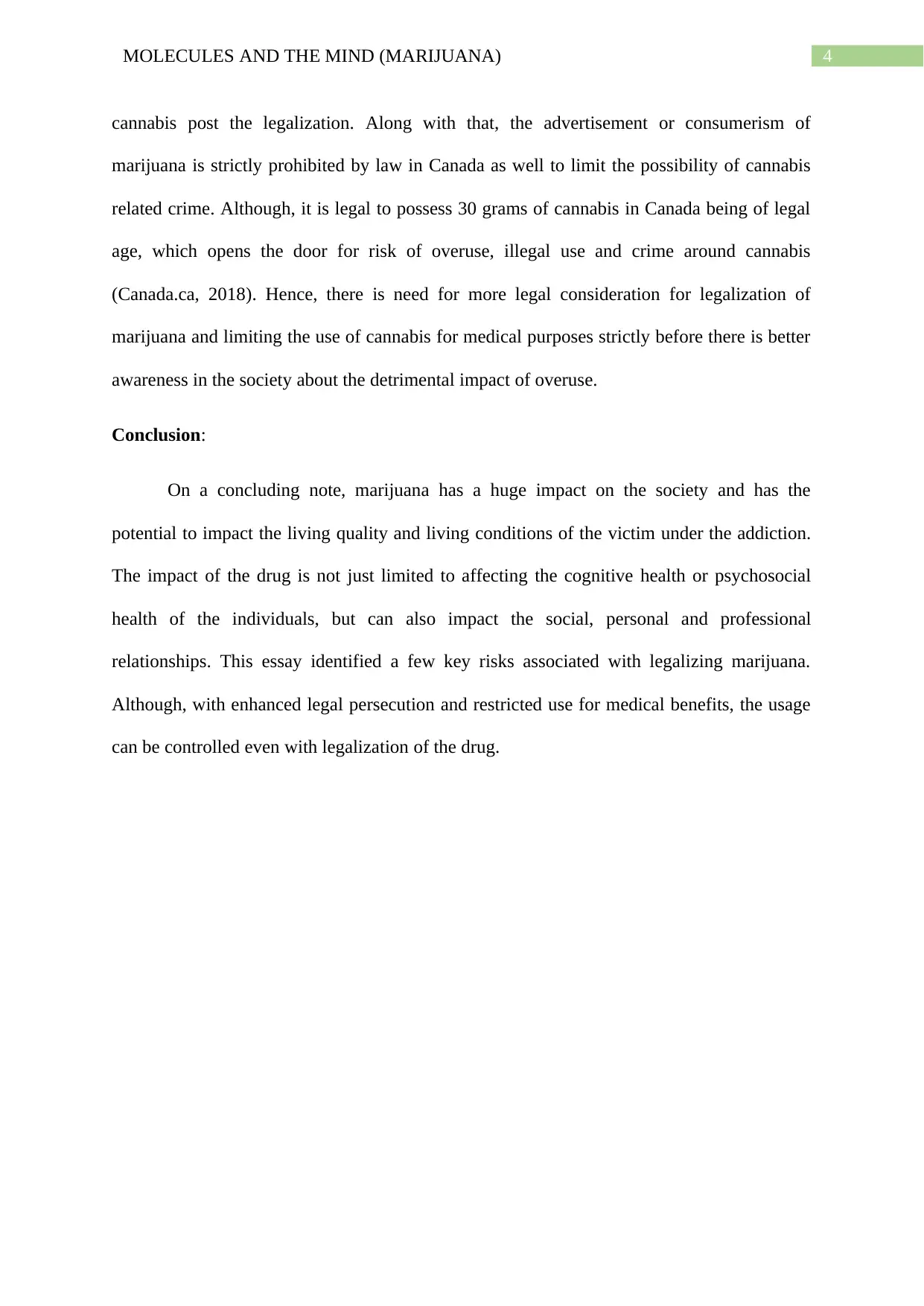
4MOLECULES AND THE MIND (MARIJUANA)
cannabis post the legalization. Along with that, the advertisement or consumerism of
marijuana is strictly prohibited by law in Canada as well to limit the possibility of cannabis
related crime. Although, it is legal to possess 30 grams of cannabis in Canada being of legal
age, which opens the door for risk of overuse, illegal use and crime around cannabis
(Canada.ca, 2018). Hence, there is need for more legal consideration for legalization of
marijuana and limiting the use of cannabis for medical purposes strictly before there is better
awareness in the society about the detrimental impact of overuse.
Conclusion:
On a concluding note, marijuana has a huge impact on the society and has the
potential to impact the living quality and living conditions of the victim under the addiction.
The impact of the drug is not just limited to affecting the cognitive health or psychosocial
health of the individuals, but can also impact the social, personal and professional
relationships. This essay identified a few key risks associated with legalizing marijuana.
Although, with enhanced legal persecution and restricted use for medical benefits, the usage
can be controlled even with legalization of the drug.
cannabis post the legalization. Along with that, the advertisement or consumerism of
marijuana is strictly prohibited by law in Canada as well to limit the possibility of cannabis
related crime. Although, it is legal to possess 30 grams of cannabis in Canada being of legal
age, which opens the door for risk of overuse, illegal use and crime around cannabis
(Canada.ca, 2018). Hence, there is need for more legal consideration for legalization of
marijuana and limiting the use of cannabis for medical purposes strictly before there is better
awareness in the society about the detrimental impact of overuse.
Conclusion:
On a concluding note, marijuana has a huge impact on the society and has the
potential to impact the living quality and living conditions of the victim under the addiction.
The impact of the drug is not just limited to affecting the cognitive health or psychosocial
health of the individuals, but can also impact the social, personal and professional
relationships. This essay identified a few key risks associated with legalizing marijuana.
Although, with enhanced legal persecution and restricted use for medical benefits, the usage
can be controlled even with legalization of the drug.
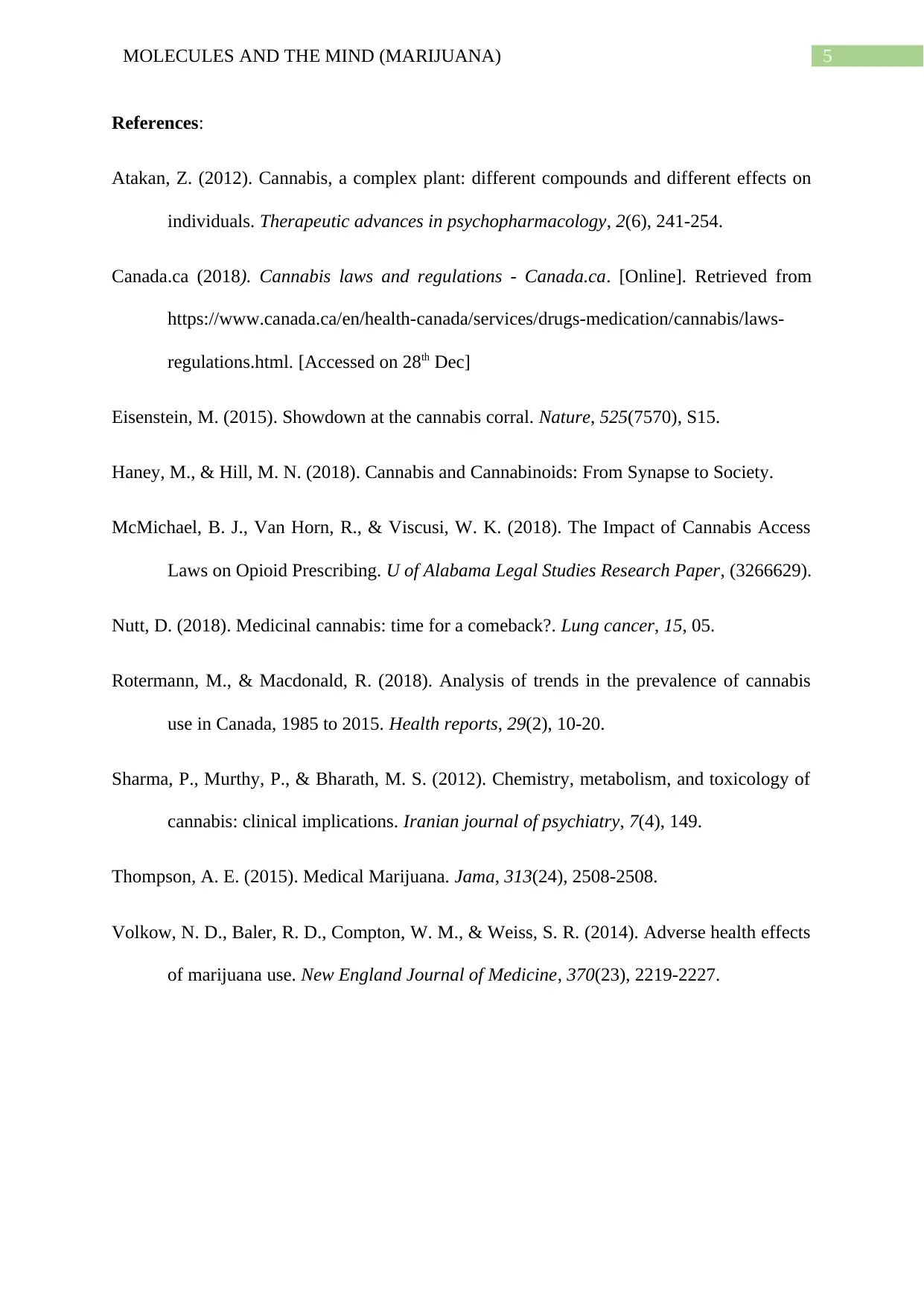
5MOLECULES AND THE MIND (MARIJUANA)
References:
Atakan, Z. (2012). Cannabis, a complex plant: different compounds and different effects on
individuals. Therapeutic advances in psychopharmacology, 2(6), 241-254.
Canada.ca (2018). Cannabis laws and regulations - Canada.ca. [Online]. Retrieved from
https://www.canada.ca/en/health-canada/services/drugs-medication/cannabis/laws-
regulations.html. [Accessed on 28th Dec]
Eisenstein, M. (2015). Showdown at the cannabis corral. Nature, 525(7570), S15.
Haney, M., & Hill, M. N. (2018). Cannabis and Cannabinoids: From Synapse to Society.
McMichael, B. J., Van Horn, R., & Viscusi, W. K. (2018). The Impact of Cannabis Access
Laws on Opioid Prescribing. U of Alabama Legal Studies Research Paper, (3266629).
Nutt, D. (2018). Medicinal cannabis: time for a comeback?. Lung cancer, 15, 05.
Rotermann, M., & Macdonald, R. (2018). Analysis of trends in the prevalence of cannabis
use in Canada, 1985 to 2015. Health reports, 29(2), 10-20.
Sharma, P., Murthy, P., & Bharath, M. S. (2012). Chemistry, metabolism, and toxicology of
cannabis: clinical implications. Iranian journal of psychiatry, 7(4), 149.
Thompson, A. E. (2015). Medical Marijuana. Jama, 313(24), 2508-2508.
Volkow, N. D., Baler, R. D., Compton, W. M., & Weiss, S. R. (2014). Adverse health effects
of marijuana use. New England Journal of Medicine, 370(23), 2219-2227.
References:
Atakan, Z. (2012). Cannabis, a complex plant: different compounds and different effects on
individuals. Therapeutic advances in psychopharmacology, 2(6), 241-254.
Canada.ca (2018). Cannabis laws and regulations - Canada.ca. [Online]. Retrieved from
https://www.canada.ca/en/health-canada/services/drugs-medication/cannabis/laws-
regulations.html. [Accessed on 28th Dec]
Eisenstein, M. (2015). Showdown at the cannabis corral. Nature, 525(7570), S15.
Haney, M., & Hill, M. N. (2018). Cannabis and Cannabinoids: From Synapse to Society.
McMichael, B. J., Van Horn, R., & Viscusi, W. K. (2018). The Impact of Cannabis Access
Laws on Opioid Prescribing. U of Alabama Legal Studies Research Paper, (3266629).
Nutt, D. (2018). Medicinal cannabis: time for a comeback?. Lung cancer, 15, 05.
Rotermann, M., & Macdonald, R. (2018). Analysis of trends in the prevalence of cannabis
use in Canada, 1985 to 2015. Health reports, 29(2), 10-20.
Sharma, P., Murthy, P., & Bharath, M. S. (2012). Chemistry, metabolism, and toxicology of
cannabis: clinical implications. Iranian journal of psychiatry, 7(4), 149.
Thompson, A. E. (2015). Medical Marijuana. Jama, 313(24), 2508-2508.
Volkow, N. D., Baler, R. D., Compton, W. M., & Weiss, S. R. (2014). Adverse health effects
of marijuana use. New England Journal of Medicine, 370(23), 2219-2227.
⊘ This is a preview!⊘
Do you want full access?
Subscribe today to unlock all pages.

Trusted by 1+ million students worldwide

6MOLECULES AND THE MIND (MARIJUANA)
1 out of 7
Your All-in-One AI-Powered Toolkit for Academic Success.
+13062052269
info@desklib.com
Available 24*7 on WhatsApp / Email
![[object Object]](/_next/static/media/star-bottom.7253800d.svg)
Unlock your academic potential
Copyright © 2020–2025 A2Z Services. All Rights Reserved. Developed and managed by ZUCOL.